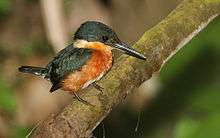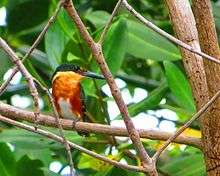American pygmy kingfisher
| American pygmy kingfisher | |
|---|---|
 | |
| Male | |
| Scientific classification | |
| Kingdom: | Animalia |
| Phylum: | Chordata |
| Class: | Aves |
| Order: | Coraciiformes |
| Genus: | Chloroceryle |
| Species: | C. aenea |
| Binomial name | |
| Chloroceryle aenea (Pallas, 1764) | |
The American pygmy kingfisher (Chloroceryle aenea) is a resident breeding kingfisher which occurs in the American tropics from southern Mexico south through Central America to western Ecuador, and then around the northern Andes cordillera in the east to central Bolivia and central Brazil. The species occupies the entire Amazon basin and the Tocantins River drainage adjacent in Pará state Brazil. It also occurs on Trinidad.
Taxonomy
Two subspecies are currently recognized, including the nominate subspecies:[2]
The nominate southern C. a. aenea has two lines of white spots on the wings, while the northern C. a. stictoptera has three or four lines of spots and a concealed white patch of feathers on the undertail. The two forms intergrade in central Costa Rica.
Description

The American pygmy kingfisher is 13 cm long and weighs 18g. It has the typical kingfisher shape, with a short tail and long bill. It is oily green above, with a yellow-orange collar around the neck, rufous underparts and a white belly. The female has a narrow green breast band. Young birds resemble the adults, but have paler rufous underparts, no breast band, and speckled wings and flanks. It gives a weak tik or stony cht cht call.
Distribution and habitat
This tiny kingfisher occurs in dense forests and mangrove swamps along small streams or rivers with heavily vegetated banks. The unlined nest is in a horizontal tunnel up to 40 cm long made in a river bank, earth heap, or occasionally an arboreal termite nest. The female lays three, sometimes four, white eggs.
American pygmy kingfishers perch quietly on a low branch close to water before plunging in head first after small fish or tadpoles. They will also hawk for insects. They not shy, but easily overlooked as they sit silently amongst riverside branches.
References
- ↑ BirdLife International (2012). "Chloroceryle aenea". IUCN Red List of Threatened Species. Version 2013.2. International Union for Conservation of Nature. Retrieved 26 November 2013.
- ↑ "Chloroceryle aenea". Integrated Taxonomic Information System. Retrieved 5 May 2011.
- ffrench, Richard (1991). A Guide to the Birds of Trinidad and Tobago (2nd ed.). Boston: Comstock Publishing. ISBN 0-8014-9792-2.
- Fry, C. H.; Fry, Kathie; Harris, Alan (1999). Kingfishers, Bee-eaters and Rollers. London: Christopher Helm. ISBN 0-7136-5206-3.
- Hilty, Steven L (2003). Birds of Venezuela. London: Christopher Helm. ISBN 0-7136-6418-5.
- Stiles, F. Gary; Skutch, Alexander F. (1990). A Guide to the Birds of Costa Rica. Ithaca, N.Y: Comstock Publishing. ISBN 0-8014-9600-4.
External links
| Wikimedia Commons has media related to Chloroceryle aenea. |
| Wikispecies has information related to: Chloroceryle aenea |
- American pygmy kingfisher videos, photos & sounds on the Internet Bird Collection
- Stamps (for El Salvador) with RangeMap
- Photo; Article borderland-tours
- American pygmy kingfisher photo gallery VIREO Photo-High Res
